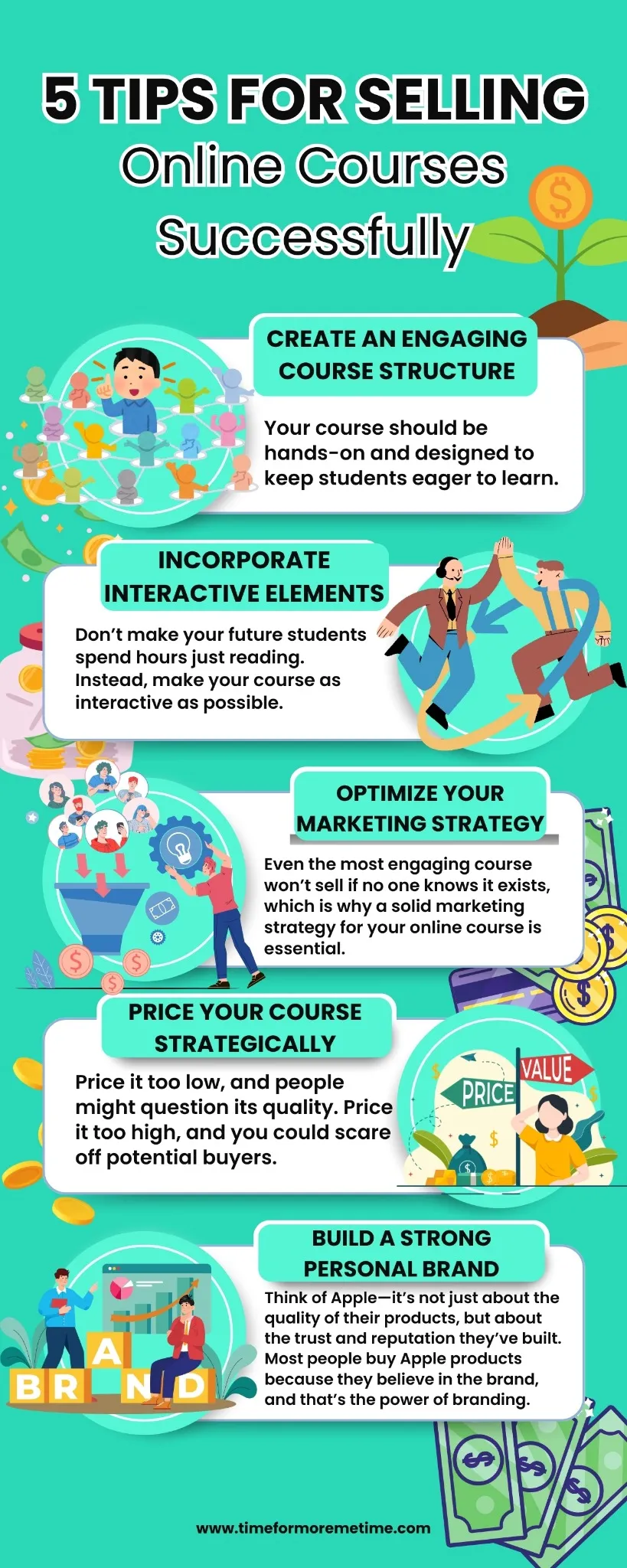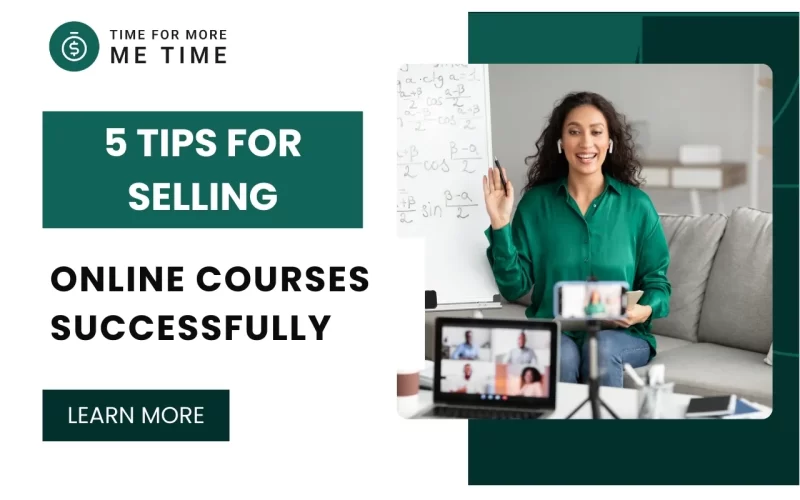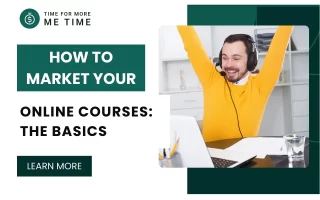
So, you’ve decided to sell online courses. You’re probably here because you need hacks for selling online courses successfully. Or maybe you haven’t started yet because you’re unsure how to make it successful.
Don’t worry—I’m here to help. In this short post, I’ll share simple, actionable tips to help you master the basics and increase your chances of making sales. Think of this as a free crash course on how to sell an online course.
I’ve been learning from online courses for years, and I’ve spent countless hours researching and analyzing what works. While I haven’t launched my own course yet due to time constraints, I’ve gained valuable insights, especially on the marketing side of things.
Let me share what I’ve learned so far to help you on your journey, so let’s get started!
1. Create An Engaging Course Structure

First, understand that creating and selling online courses is more than just uploading videos. You need to attract students who are genuinely interested in your course and motivated to complete it.
If you feel learners won’t even get halfway through your material, there’s a good chance they won’t buy your course in the first place. And if learners don’t finish the content, all your hard work goes unnoticed.
Your primary goal is to ensure you develop engaging course content. That doesn’t mean just throwing together a bunch of random videos and calling it a day.
Your course should be hands-on and designed to keep students eager to learn. One effective strategy is breaking your material into short, digestible lessons.
This approach helps retain their attention, allows for breaks, and prevents them from feeling overloaded or overwhelmed by too much information at once.
Another technique is incorporating storytelling to improve understanding.
Everyone loves stories—especially relatable ones. Stories create emotional connections, helping learners engage with your content on a deeper level and invest in your course.
Finally, don’t forget to include real-world examples or case studies.
Fictional stories can grab attention, but real-life examples build trust and credibility. When students see practical applications of what you’re teaching, they’re more likely to believe in its value and stay committed.
2. Incorporate Interactive Elements
Trust me on this: even though I love reading, I struggle to stay focused on an online course for an hour straight. With platforms like YouTube offering engaging video tutorials, how can a text-heavy course possibly compete?
So, don’t make your future students spend hours just reading. Instead, make your course as interactive as possible.
Start with something simple, like adding multiple-choice quizzes. These give students a chance to use their fingers and mouse, challenging their intellect while keeping them actively engaged.
You can also take it up a notch with other interactive elements, such as live polls, group projects, or even virtual reality experiences if your platform allows.
Discussion forums and live Q&A sessions are fantastic for fostering a sense of community and encouraging peer-to-peer learning.
Remember, interactive elements not only keep students engaged but also help reinforce their learning. That said, I get that the features you can include will depend on the course platform you use—so choose wisely!
3. Optimize Your Marketing Strategy

Let’s shift the focus from course content to marketing. Even the most engaging course won’t sell if no one knows it exists, which is why a solid marketing strategy for your online course is essential.
Start by identifying your target audience—who exactly will benefit from your course? The more specific you are, the easier it will be to craft messaging that resonates with their needs and goals.
Leverage social media platforms to promote your course by creating short, value-packed content that offers potential students a sneak peek of what they’ll gain.
You can also run targeted ads, offer a free mini-course or webinar as a teaser, or build an email list to nurture leads over time.
Don’t underestimate the power of testimonials and reviews. Reach out to early students or beta testers for feedback and share their success stories publicly. Real-world results build credibility and motivate others to trust your course.
4. Price Your Course Strategically
This one’s unavoidable—pricing your course strategically can make or break its success. Price it too low, and people might question its quality. Price it too high, and you could scare off potential buyers.
Start by researching your competitors and evaluating your course’s value. What unique benefits does your course offer? Would you personally feel confident paying the price you’re asking?
Consider experimenting with tiered pricing. Offer a basic package at a lower price for those with a tighter budget, while providing premium options that include extras like bonus modules, live sessions, or one-on-one coaching.
This strategy broadens your reach and maximizes your revenue potential.
Additionally, use tactics like limited-time discounts or early-bird pricing to create a sense of urgency and drive immediate purchases.
Be sure to pair these offers with clear, compelling value propositions so learners know exactly what they’re getting and why it’s worth the price.
5. Build A Strong Personal Brand

In addition to your course, you’re also selling your personal brand. Think of Apple—it’s not just about the quality of their products, but about the trust and reputation they’ve built.
Most people buy Apple products because they believe in the brand, and that’s the power of branding.
A strong personal brand can help you beyond just course sales—it can increase website traffic, boost video views, and establish your authority in your niche.
So, remember, creating a successful online course isn’t just about the content—it’s also about you. Your personal brand plays a huge role in building trust and attracting students.
People are more likely to invest in your course if they feel connected to you and confident in your expertise.
Start by positioning yourself as an authority in your field. Share your expertise through blog posts, social media content, YouTube videos, or podcasts. Offer valuable tips, insights, or solutions to common problems your audience faces.
Consistency in your messaging and tone will help you stand out and become recognizable.
Engage directly with your audience by answering questions, responding to comments, and hosting live sessions. This interaction builds rapport and shows your dedication to helping others succeed.
Finally, refine your online presence.
A professional website with clear course details, testimonials, and your personal story as a creator can make a significant impact. Ensure your social media profiles align with your expertise and the course you offer.
When your personal brand is strong, students won’t just buy your course—they’ll buy into you. This connection can lead to long-term loyalty, repeat purchases, and referrals.
Conclusion
Alright, folks, those were my top tips to help make your course more sellable from the moment potential learners come across it.
It’s not always easy work, but it’s definitely rewarding. So, brace yourselves. Remember, you might face setbacks, but treat them as opportunities to learn and share the lessons you’ve gained.
If you want to learn more about online courses, from creating to marketing, read our articles or watch these videos on our YouTube channel!






